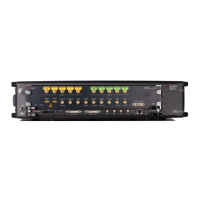New seq (New Sequence)
Select the check box to start a new sequence. Total number of sequences are
displayed by the counter “Sequence count.”
Seq. Loop (Sequence Loop)
Specifies the sequence loop count (number of times the selected sequence is to be
repeated).
Seq.Adv. (Sequence Advance)
Allows the user to set the sequence advancement mode.
Any of the following sequence advancement modes can be selected:
Auto (Automatic): After having executed all loops, the sequencer
advances to the next sequence automatically. No external interaction is
required for advancement.
Cond (Conditional): The sequencer repeats the current sequence until it
receives the correct advancement event. After having received the
advancement event, the current sequence is played to the end before
switching to the next one.
Repeat: After having executed all loops the sequencer stops and plays the
last value of the current sequence. After having received the
advancement event, the sequencer starts playing the next sequence.
When receiving the advancement event before having played all
repetitions, all repetitions will be played before moving to the next
sequence.
Single: Once a sequence is exectued, the sequencer stops and plays the
last value of the sequence. After having received the next advancement
event, the process is repeated until having executed all loops of the
current sequence. Then the execution advances to the next sequence.
Ampl.Tbl. (Amplitude Table)
Init: This option initializes the address pointer of the amplitude table to
index zero (first entry) and causes the amplitude table value of index zero
(first entry) to be transferred to the DAC. The new amplitude
multiplication factor becomes active immediately (see Section 4.3.1).
Next: This option increments the address pointer of the amplitude table
by one and causes the amplitude table value of the new index to be
transferred to the DAC. The new amplitude multiplication factor becomes
active immediately (see Section 4.3.1).
Freq.Tbl. (Frequency Table)
Init: This option initializes the address pointer of the frequency table to
index zero (first entry) and causes the frequency table value of index zero
(first entry) to be transferred to the DAC. The new NCO frequency value
becomes active immediately (see Section 4.3.1).
Next: This option increments the address pointer of the frequency table by
one and causes the frequency table value of the new index to be
transferred to the DAC. The new NCO frequency value becomes active
immediately (see Section 4.3.1).
Idle Delay
The field is enabled only when the Entry Type is chosen as “Idle”. It is used to insert
a numeric idle delay value into the sequence.
Idle Samp. (Idle Sample)
Idle Sample is the sample played during the pause time. The field is enabled only
when the Entry Type is chosen as “Idle”. It is used to insert a numeric idle sample
value into the sequence. In case of interpolated mode, there are two idle sample
values corresponding to I and Q data, respectively. So, for interpolated mode there

